loading...
- No. 9, Xingyuan South Street, Dongwaihuan Road, Zaoqiang County, Hengshui, Hebei, China
- admin@zjcomposites.com
- +86 15097380338
- Welcome to visit our website!
Innovative Designs and Applications of FRP Vessels in Modern Industry
Understanding FRP Vessels Innovations and Applications
Fiber-Reinforced Polymer (FRP) vessels have gained remarkable popularity across various industries due to their unique properties and advantages over traditional materials. As a composite material made from a polymer matrix reinforced with fiber, usually glass, carbon, or aramid, FRP presents an attractive solution for many applications requiring lightweight, durability, and resistance to corrosion. This article delves into the characteristics, applications, and considerations concerning FRP vessels.
Properties of FRP Vessels
The inherent properties of FRP vessels make them well-suited for a variety of applications. Some of the key characteristics include
1. Lightweight FRP is significantly lighter than metals, which enhances handling and reduces transportation costs. This property is particularly beneficial in applications where weight is a critical factor, such as in marine or aerospace industries.
2. Corrosion Resistance One of the standout features of FRP is its exceptional resistance to chemical corrosion. Unlike metals, which can rust or degrade when exposed to harsh environments, FRP retains its structural integrity when exposed to chemicals, moisture, and extreme temperatures. This makes it an ideal choice for storing and transporting corrosive materials.
3. High Strength-to-Weight Ratio While being lightweight, FRP vessels also exhibit high tensile strength. This balance of low weight and high strength allows for superior performance in structural applications.
4. Thermal Insulation FRP materials offer good thermal insulating properties, which is particularly useful in applications where temperature control is essential.
5. Design Flexibility The manufacturing processes for FRP allow for complex shapes and designs, which can be tailored to specific needs. This adaptability can enhance product design and functionality, making FRP vessels suitable for custom applications.
Applications of FRP Vessels
Given their advantageous properties, FRP vessels find applications across various sectors
1. Chemical Storage FRP tanks are extensively used in the chemical industry for the storage and transport of aggressive chemicals. Their resistance to corrosion and leakage minimizes the risk of environmental contamination and ensures safety.
frp vessels

2. Water Treatment In municipal and industrial water treatment processes, FRP vessels are employed for processes such as filtration, tank storage, and as pressure vessels that withstand the rigors of water treatment chemicals.
3. Marine Industry The lightweight nature of FRP makes it a popular choice for components of boats and ships, such as fuel tanks and hulls. Their resistance to water and corrosion significantly extends the lifespan of marine structures.
4. Food and Beverage Industry FRP vessels are also utilized in the food and beverage sector for storage tanks, as they do not contribute to contamination and are easy to clean, maintaining hygiene standards.
5. Pharmaceuticals In pharmaceutical manufacturing, FRP vessels are used to store various chemicals and compounds due to their inertness and ability to thwart contamination risks.
Challenges and Considerations
Despite the numerous benefits of FRP vessels, there are challenges and considerations that need to be addressed
1. Cost The initial manufacturing cost of FRP vessels can be higher than traditional materials, which might deter some industries from adoption. However, the long-term savings due to reduced maintenance and replacement costs often justify the initial investment.
2. Temperature Limitations While FRP displays excellent thermal insulation properties, extreme temperatures can affect its structural integrity. It's essential to evaluate temperature tolerances based on application requirements.
3. UV Degradation Over prolonged exposure to sunlight, certain types of FRP can degrade. Proper coatings and treatment can mitigate this issue, but it's an important consideration for outdoor applications.
4. Environmental Impact and Recycling The environmental sustainability of FRP products is a growing concern. Developing effective recycling methods for FRP waste is crucial as industries move towards greener practices.
Conclusion
FRP vessels represent a significant advancement in materials technology, offering numerous advantages that cater to a wide range of industries. Their exceptional characteristics, including lightweight design, corrosion resistance, and versatility, position them as a key player in modern manufacturing processes. While challenges exist, the ongoing advancements in FRP technology and applications suggest a promising future for these innovative vessels. As industries continue to embrace sustainability and innovation, FRP vessels will likely play an increasingly important role in shaping the landscape of materials engineering.
-
The Rise of FRP Profiles: Strong, Lightweight, and Built to LastNewsJul.14,2025
-
SMC Panel Tanks: A Modern Water Storage Solution for All EnvironmentsNewsJul.14,2025
-
GRP Grating: A Modern Solution for Safe and Durable Access SystemsNewsJul.14,2025
-
Galvanized Steel Water Tanks: Durable, Reliable, and Ready for UseNewsJul.14,2025
-
FRP Mini Mesh Grating: The Safer, Smarter Flooring SolutionNewsJul.14,2025
-
Exploring FRP Vessels: Durable Solutions for Modern Fluid HandlingNewsJul.14,2025
-
GRP Structures: The Future of Lightweight, High-Performance EngineeringNewsJun.20,2025
